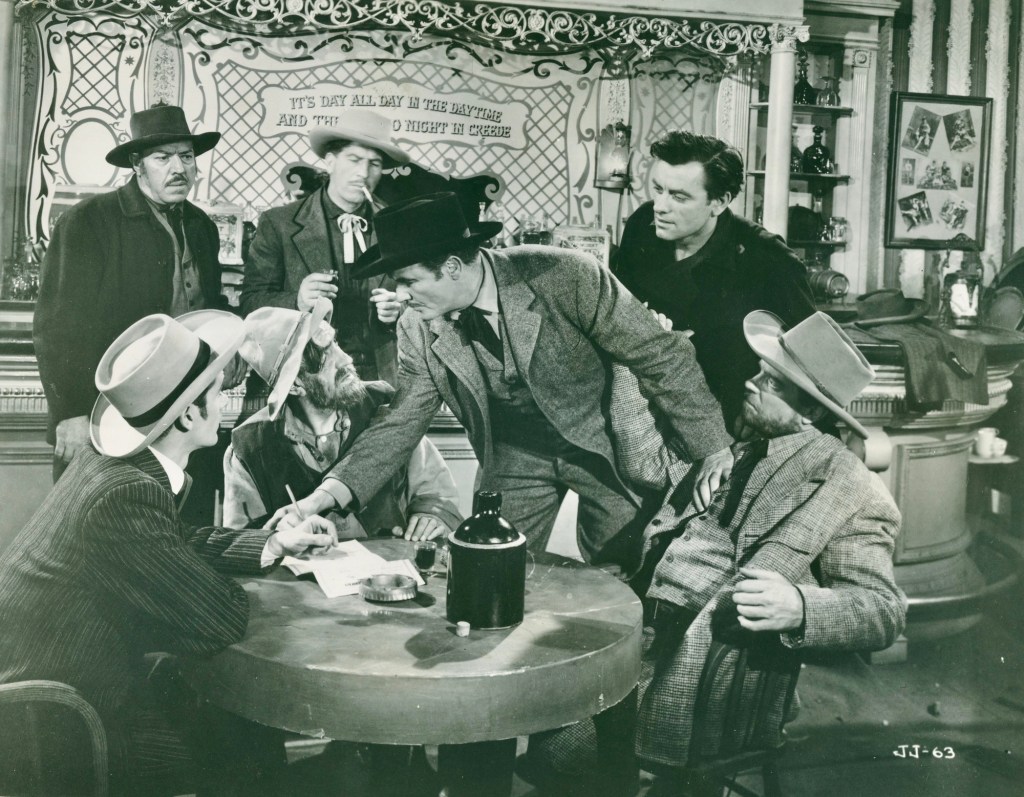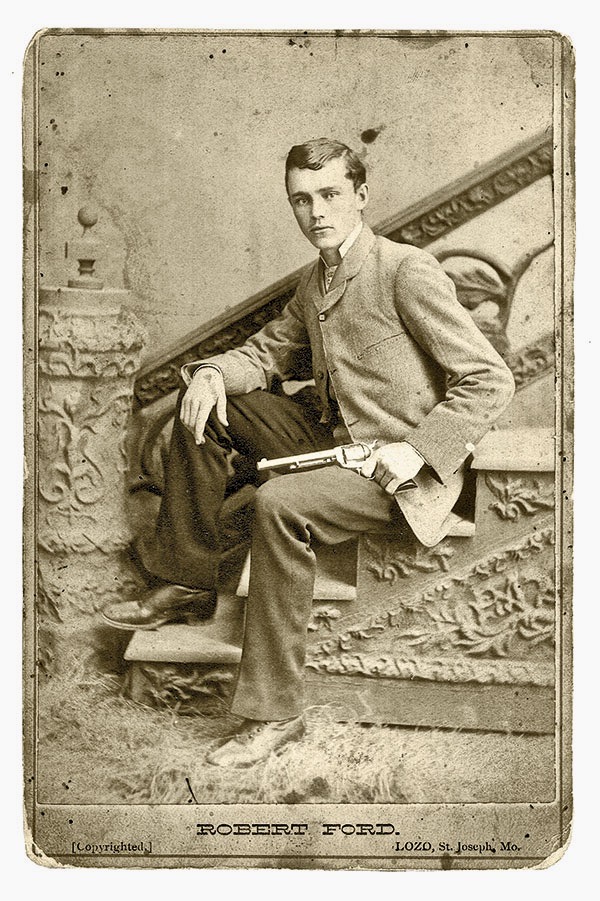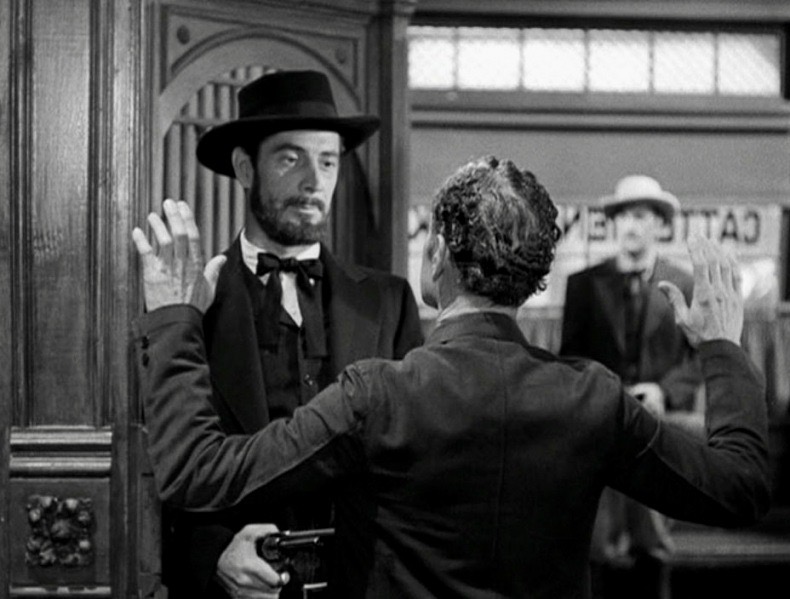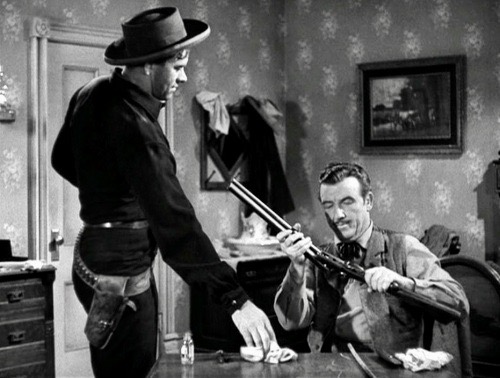
After recently rewatching I Shot Jesse James on DVD from Criterion’s Eclipse label, I couldn’t get a certain scene out of my head. As you may know, this 1949 film is Samuel Fuller’s directorial debut about Robert Ford, the “dirty little coward” who assassinated the frontier legend in 1882 and the scene that pops out occurs not long after Jesse (played by Reed Hadley) is dead and buried. Ford (John Ireland) begins performing re-enactments of the event on stages for money as he travels around capitalizing on his notoriety. At first, I thought this was just a fantasy from Fuller’s fevered, pulp fiction imagination but after doing some research it appears to be true. Robert Ford really did take his act on the road, billing it as “Outlaws of Missouri,” and, night after night before paying audiences, he would act out that fateful day when he shot Jesse James.

The concept is mind-boggling but it makes you realize that not everyone was staying at home reading by candlelight in the good old days. Think about it. What could be more fascinating than seeing a controversial figure like Robert Ford re-enact an incident that had already passed into legend? Of course, it would be staged and artificial, acted out in fleapit theaters and saloons with minimal props, but that would only add to the total fascination and curiosity value. One can only imagine what some publicist could do with this concept in today’s Hollywood. Live on stage at the Roxy this week OJ in” If I HAD Murdered Nicole Simpson” or maybe Rudy Giuliani’s “The Secret Ukraine Scandal.”

Robert Ford’s road tour act wasn’t really unusual for that era. In fact, Buffalo Bill took the concept and expanded it into a Wild West show in 1883, the year after Jesse’s death, featuring a cast of famous, real life frontier legends including Annie Oakley and Sitting Bull. Playwright Arthur Kopit would base his play “Indians” on this odd historical happening and Robert Altman would bring it to the screen in 1976 as Buffalo Bill and the Indians, or Sitting Bull’s History Lesson with Paul Newman as Buffalo Bill, Geraldine Chaplin as Annie Oakley and Frank Kaquitts as Sitting Bull.
Altman’s approach is satire at its most cynical and an unsubtle debunking of American history but the real facts are even more outrageous. In Buffalo Bill’s actual show, Oakley would demonstrate her famous sharpshooting skills with a rifle but audiences were more fascinated by the Sioux chief whose forces had massacred General Custer and his troops at Little Bighorn. For a small price they could see the once fearsome warrior ride his horse around the circus ring and even get an autographed picture from him. Just prior to joining Buffalo Bill’s carnival, Sitting Bull had been living on the Standing Rock Agency reservation in Fort Yates, North Dakota under the strict supervision of the U.S. military. But in 1885, he was allowed to leave Fort Yates to tour with Buffalo Bill’s show for approximately $50 a week. It’s not surprising that he could only stand it for four months before returning to Standing Rock where his presence was a constant threat to the government. He was killed by Native American police in 1890 for allegedly resisting arrest for suspicion of inciting rebellion among his people, a charge that was never proved.

Regarding I Shot Jesse James, Sam Fuller’s low budget Western must have been an unusual experience for audiences expecting the usual bang, bang, shoot-em-up wild west programmer. This was something else. It is a portrait of an aberrant personality who has few redeeming values and makes a decision that paves the way for his own self-destruction. Not the typical Western hero. No, Fuller loved the idea of an anti-hero and stated in his autobiography, “I wanted to show Ford realizing that he’s sick, then follow him as he sinks deeper into this sickness.”

In Fuller’s film, we are never quite sure of the real reason why Ford shoots Jesse. He says he did it so he could be free to marry Cynthy Waters (Barbara Britton), the girl he loves but who seems to regard him as something of a stalker. According to most historic accounts, he did it to avoid going to prison; Missouri Governor Thomas T. Crittenden told him he would get a full pardon for his previous involvement with the James gang if he shot James – plus he would be pardoned for Jesse’s death and receive the reward money.

Fuller intimates the murder may also have been prompted by a twisted love/hate relationship between the two men and shows us a scene where Ford is ordered to scrub Jesse’s back while he’s in the bathtub. The homoerotic implications are too blatant to be unintentional and some critics noted this calling I Shot Jesse James “the first adult Western.” But Fuller never bought into the Jesse James myth, regarding the outlaw as a “bisexual…a low-down thief, a pervert, and a sonofabitch” and made it obvious “something is warped about these two guys’ relationship.” Now I think the real reason Bob Ford killed his “best friend” is because he was damn sick of washing Jesse’s backside and who knows what else?

Initially, Sam Fuller had a different story idea for his debut feature. He wanted to make a film about Cassius, the Roman senator who instigated the plot to kill Julius Caesar but producer Robert J. Lippert had no interest in bankrolling a period piece nor did he have the budget for something that ambitious. Instead they went with Fuller’s second idea about the man who killed Jesse James. The director had read Homer Croy’s magazine story about the famous outlaw in American Weekly and cobbled out his own screenplay that focused more on Bob Ford’s betrayal and guilt. Screen tough guy and notorious boozer/brawler Lawrence Tierney was suggested for the role of Ford but got nixed with Fuller choosing John Ireland after being impressed with his performance in Red River. The film was shot over a ten-day period on a rented set at Republic Studios, got picked up for national distribution and received decent, if not exactly rave, reviews from most film critics.

Ironically, I Shot Jesse James was more favorably reviewed in Europe, especially France. Fuller stated in his autobiography, A Third Face, that “a French critic wrote that the close-ups in my movie had “an oppressive intensity the cinema has not experienced since Dreyer’s Joan of Arc.” The critic’s name was Jean-Luc Godard.”
If you want to seek out other films about Jesse James, there are plenty to choose from these days. One of the more intriguing accounts of this mythic figure is Andrew Dominik’s 2007 biopic, The Assassination of Jesse James by the Coward Robert Ford with Brad Pitt as Jesse and Casey Affleck as Robert (He received an Oscar nomination for Best Supporting Actor).

The most famous rendition is probably the 1939 box office hit, Jesse James, directed by Henry King with Tyrone Power in the title role. This is a highly fictionalized account but it boasts an excellent supporting cast that includes Henry Fonda, Nancy Kelly, Randolph Scott, Brian Donlevy and John Carradine as Bob Ford. Jesse James’ own granddaughter reputedly said “about the only connection it has with fact is that there once was a man named Jesse and he did ride a horse.”

Nicholas Ray’s The True Story of Jesse James (1956), despite the promise of its title, wasn’t much more truthful or accurate in its depiction of the outlaw. It was highly melodramatic, however, with Ray treating Jesse (Robert Wagner) as a misunderstood youth in the manner of his earlier Rebel Without a Cause (1955) starring James Dean.
There are at least ten or more westerns in which Jesse James is a central character, if not the main protagonist, and focus on various aspects of his gang and career. Among the better known and more popular titles are Philip Kaufman’s The Great Northfield Minnesota Raid (1972), with covers the exploits of the Jesse James-Cole Younger gang with Robert Duvall as Jesse and Walter Hill’s The Long Riders (1980), which is another variation on the James-Younger gang featuring the stunt casting of actor brothers (the Keach, the Carradine and the Guest siblings) as gang members.

I Shot Jesse James is available on DVD from the Criterion Collection as part of the Eclipse series in a 3-film set entitled The First Films of Samuel Fuller that also includes The Baron of Arizona and The Steel Helmet. I Shot Jesse James is not available as a separate release from Criterion but you can find a solo DVD of it from Medusa Films although I can’t vouch for the video/audio quality.
Other links of interest:
https://www.newyorker.com/magazine/2002/11/25/directors-cut
https://www.history.com/news/7-things-you-might-not-know-about-jesse-james
https://historicmissourians.shsmo.org/historicmissourians/name/j/jamesj/




